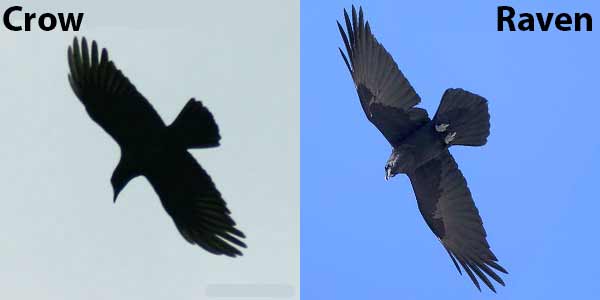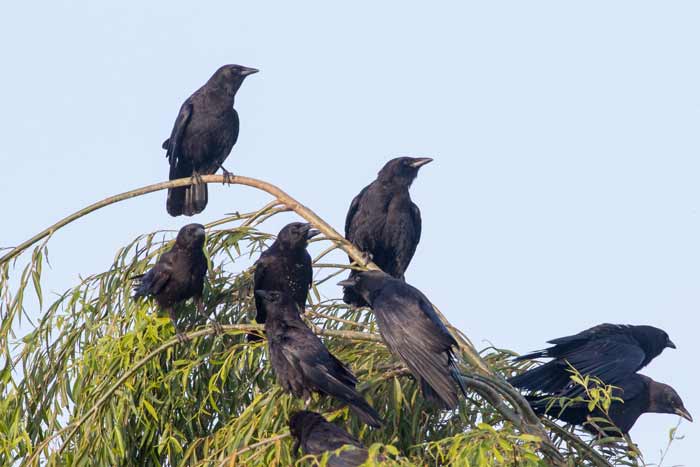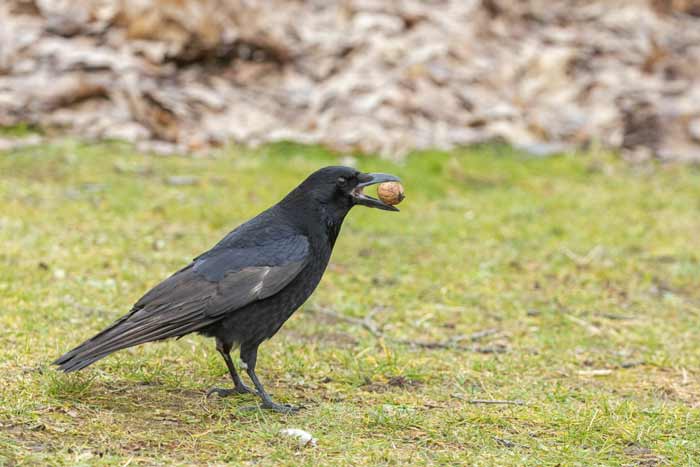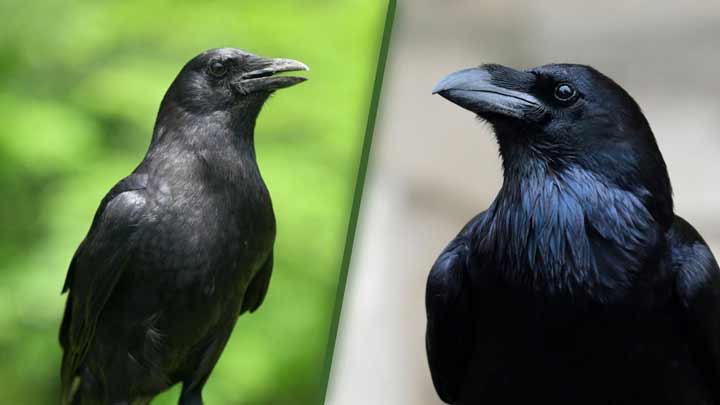In the avian kingdom, crows and ravens stand out not only for their striking black plumage but also for the intrigue and confusion they often generate.
Both members of the Corvidae family, these birds exhibit remarkable differences in size, behavior, vocalizations, and even cultural significance.
This article delves into these distinctions, offering an in-depth look at the unique traits of these intelligent and captivating birds.
Differences between Crow and Raven
| Crow | Raven | |
|---|---|---|
| Size | Smaller, typically 17-21 inches in length | Larger, about 24-27 inches in length |
| Beak Shape | Straighter and narrower | Thicker and more curved |
| Tail Shape | Fan-shaped | Wedge-shaped |
| Feather Coloration | Glossy black, sometimes with a purple or green sheen | Often iridescent, reflecting blue and purple in sunlight |
| Vocalizations | High-pitched ‘Kaw‘ sound | Deeper, more guttural sounds like “croooaaak“ |
Crow Vs Raven: Size
Crows, with their smaller and lighter frame, typically measure 17-21 inches in length. Their streamlined build is a testament to their agility and grace, particularly evident in their flight patterns.

Ravens, on the other hand, command attention with their larger and bulkier stature, measuring about 24-27 inches. This significant size difference lends ravens a more powerful and imposing presence, both in the air and on the ground.
Crow Vs Raven: Beak and Tail
The crow’s beak is straighter and narrower, reflecting its versatility in foraging and tool use. This adaptation allows crows to exploit a variety of food sources and environments.

Ravens boast a more prominent, curved beak, thicker and stronger, indicative of their adaptation to a broader range of dietary habits, including larger prey.

In flight, the crow’s fan-shaped tail aids in agile maneuvers, while the raven’s wedge-shaped tail supports its powerful and sustained flight, a key difference visible from afar.
Feather Coloration
While both birds don predominantly black feathers, ravens often exhibit a more iridescent sheen. In sunlight, their plumage can reflect mesmerizing shades of blue and purple, adding to their mystical allure.
Social Behavior

Crows are known for their sociability. Often found in large groups or ‘murders,’ especially in urban settings, they demonstrate complex social structures and communication.

Ravens, in contrast, display more solitary tendencies or are seen in pairs, particularly during the breeding season. Their preference for less populated areas contributes to their elusive reputation.
Vocalizations
The vocalization of crows is characterized by a distinctive ‘Kaw’ sound, high-pitched and nasal, echoing their presence across various landscapes.

Ravens, with their deeper, more guttural calls, produce a range of sounds including “croooaaak”, “gronk-gronk”, “tok”, and “wonk-wonk”. This vocal diversity is a hallmark of their communication.
Lifespan
Crows generally have a shorter lifespan, averaging about 7-8 years in the wild. However, in protected environments or captivity, they can live much longer, showcasing their adaptability.
Ravens enjoy a longer lifespan, with an average of 10-15 years in the wild. In captivity, some ravens have been known to live for over two decades, a testament to their resilience.
Intelligence
Both crows and ravens are celebrated for their intelligence. Renowned for their problem-solving skills and adaptability, they have been observed using tools and demonstrating complex behaviors.
Crows, particularly, have shown remarkable ingenuity in urban environments, adapting to human presence in innovative ways.
Diet

The diet of ravens is varied, including invertebrates, small mammals, carrion, and even human refuse, reflecting their opportunistic feeding habits.
Crows share a similar omnivorous diet but show a preference for fruits, nuts, seeds, and small invertebrates, adapting their feeding strategies to the availability of food sources.
Conclusion
Crows and ravens, with their distinct characteristics and behaviors, are more than mere birds; they embody intelligence, adaptability, and a certain enigmatic charm.
Understanding their differences not only aids in their identification but also deepens our appreciation for their roles in the natural world and in human culture.
As symbols of mystery and wisdom, these birds continue to captivate and inspire, reminding us of the rich tapestry of life that surrounds us.
FAQs
The key differences include size (ravens are larger), beak shape (ravens have a thicker, curved beak), tail shape (ravens have a wedge-shaped tail), feather coloration (ravens often have an iridescent sheen), and vocalizations (ravens have a deeper, more varied call).
You can distinguish them by size (crows are smaller), tail shape (crows have a fan-shaped tail), and sound (crows have a high-pitched ‘Kaw’ sound).
Crows are often found in urban and rural areas, while ravens prefer more solitary or less populated areas, such as forests and wilderness.
Both crows and ravens are highly intelligent, but crows are particularly noted for their problem-solving skills and adaptability in urban environments.
Crows generally live about 7-8 years in the wild, while ravens have a longer lifespan, averaging 10-15 years.
Crows are more social and are often found in larger groups, whereas ravens are more solitary or seen in pairs.
Ravens are known for their ability to mimic sounds, including human speech, although this is less common compared to some parrot species.




